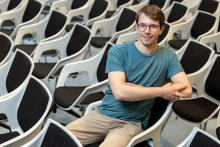If your kidneys stop working, your body is flooded with toxins and cannot survive. The only available treatment: dialysis. While the treatment works and will keep you alive, it also means you will need to visit a hospital three times a week for four-hour long sessions, and often go home feeling sick and exhausted. To help, Roberto Nese is developing membranes that could improve dialysis and, one day, lead to a portable artificial kidney that patients can wear all the time.
Roberto Nese
PhD research topic: Advancing hemodialysis technology by developing hollow fiber membranes that enhance hemocompatibility for longer dialysis therapies – part of the NXTGEN Hightech project
Work: PhD candidate at the Advanced Organ Bioengineering and Therapeutics group, Faculty of Science and Technology (TNW) at the University of Twente
Education: Master's degree in Molecular and Industrial Biotechnology at the University of Bologna (Italy)
Originally from: Italy
‘We have two kidneys that filter our blood and get rid of toxins that our body constantly produces,’ explains Nese, a PhD candidate at the Advanced Organ Bioengineering and Therapeutics group. ‘Blood goes into the maze of capillaries inside the kidneys, where toxins are actively transported and removed from the blood. Kidneys also regulate our hydration and keep a constant level of water in our body. If they can no longer fulfil these functions, the patient cannot survive without dialysis.’
Dialysis machines
Dialysis, however, doesn’t exactly mimic the process inside the body. ‘We don’t have a technology that could remove toxins directly from the blood like kidneys do. And so, we thought of doing something different,’ says Nese. ‘We are using membranes.’
A dialysis machine essentially contains blood, dialysis fluid and porous membranes. The blood is filtered, and toxins move from the blood to the dialysis fluid. ‘The first dialysis machine, developed during the Second World War, was a huge, scary machine, which consisted of a wooden drum, a water bath, and a single big membrane where the blood of patients can flow through,’ describes Nese.
(Text continues below the photo.)

Modern dialysis machines are smaller but work on the same principle. ‘Essentially, these machines contain a pump and a filter, so called dialyzer, and thousands of little membranes. Blood flows inside, goes through the tiny porous membranes so that the toxins can flow across the membrane, and the blood is purified.’
This system works but ‘it is certainly not great’, explains the PhD researcher. It is not only time consuming, mentally taxing and keeps patients bound to hospitals, but the current dialysis also doesn’t remove all the toxins from the blood. ‘Toxins are constantly produced and keep accumulating in the body. The dialysis removes a lot of them, but not all, and they keep increasing, which means you might feel okay right after dialysis, but will quickly start feeling sicker and sicker. Our kidneys work constantly, they are removing toxins all the time, but with dialysis the toxin levels go up and down.’
Better removal of toxins
Together with his colleagues, Nese is developing a better system for removal of toxins. ‘As part of the NXTGEN Hightech project, we are working toward a more continuous dialysis, but there are many challenges. One problem is that dialysis requires a huge amount of water. At the moment, we use about 500 litres per week. Another problem is that your blood pours out of your veins, out of your body, and it naturally solidifies and forms blood clots which stop the flow inside the dialysis machine. To solve this, patients are now injected with anticoagulants to prevent the formation of blood clots, but not all patients can receive anticoagulants for various reasons.’
In his doctoral research, Nese focuses on this coagulation problem. His goal is to place anticoagulant directly in the membranes, so that it doesn’t have to be injected into patients. ‘I use one type of molecule - Glycosaminoglycans (GAGs) – which is a natural anticoagulant present in our kidneys. We take what nature has developed and put it inside our membranes,’ explains the researcher.
‘Of course, this is not so simple and comes with many challenges, but by the end of my PhD, I want to have a functional membrane that contains an anticoagulant as well as another layer that absorbs toxins – a so called mixed matrix membrane.’
Artificial kidney
The ultimate goal is to develop a wearable artificial kidney, which essentially provides the patient with a non-stop dialysis. ‘The idea is to have a device where the blood comes in, gets purified and gets pumped back in the body,’ says Nese. ‘For now, however, this is science fiction rather than a realistic goal,’ he quickly adds. ‘A more realistic goal is to achieve a longer dialysis – move from four hours to eight or twelve hours, so that the toxins are removed better, and patients don’t have to go to the hospital as often. Increasing the mobility of patients is one of the main goals.’
On top of his self-proclaimed love for membranes, helping patients is Nese’s main motivation. ‘I love working in the lab and producing membranes. I’m a very organised person and I really like the idea of using membranes to organise chemical components,’ says the PhD candidate. ‘This motivates me a lot, but what I do is for the patients. It is valuable. Even if my research only helps to save one life, it is worth spending time on it. Dialysis is not something you can do forever. Organ donation is currently the only solution to kidney failure – and a better dialysis treatment can prolong patients’ lives so they can receive an organ transplant. That is what I’m working toward.’







